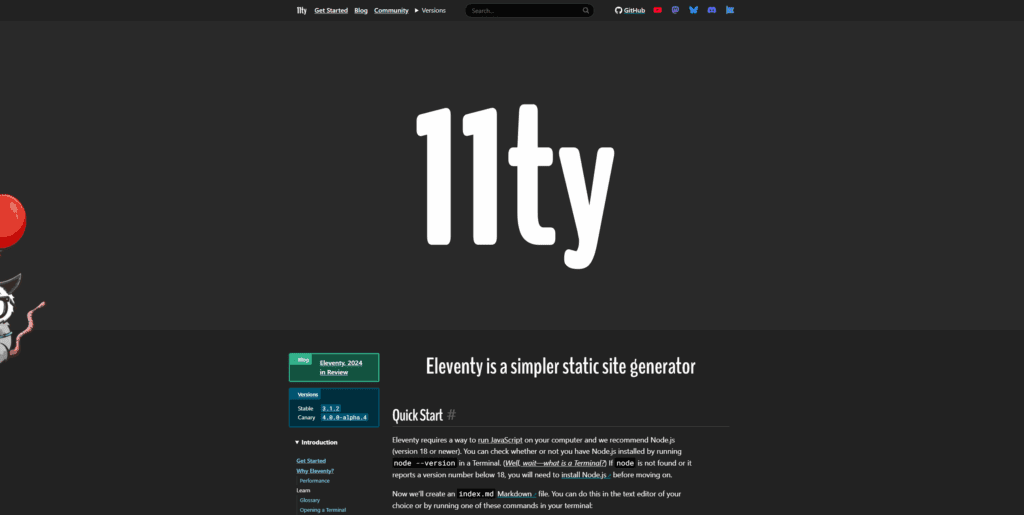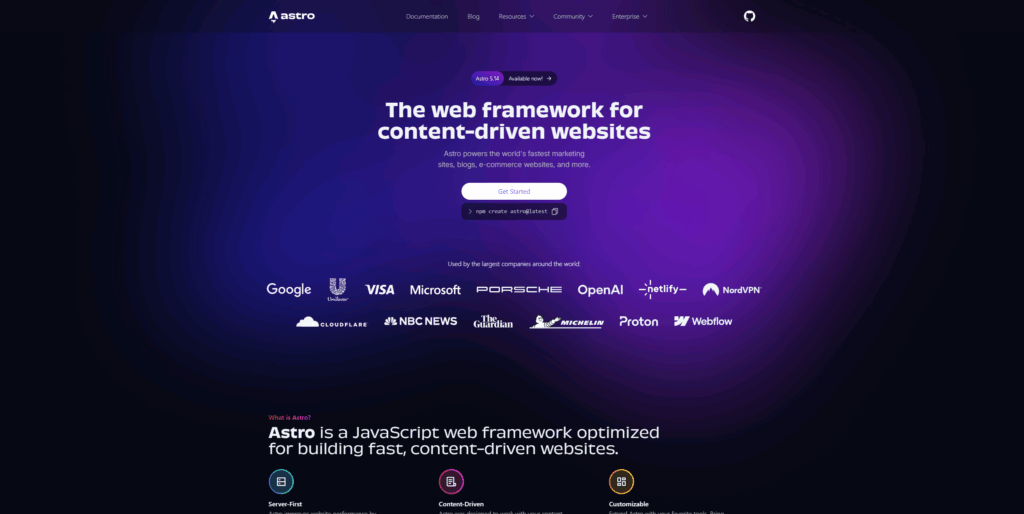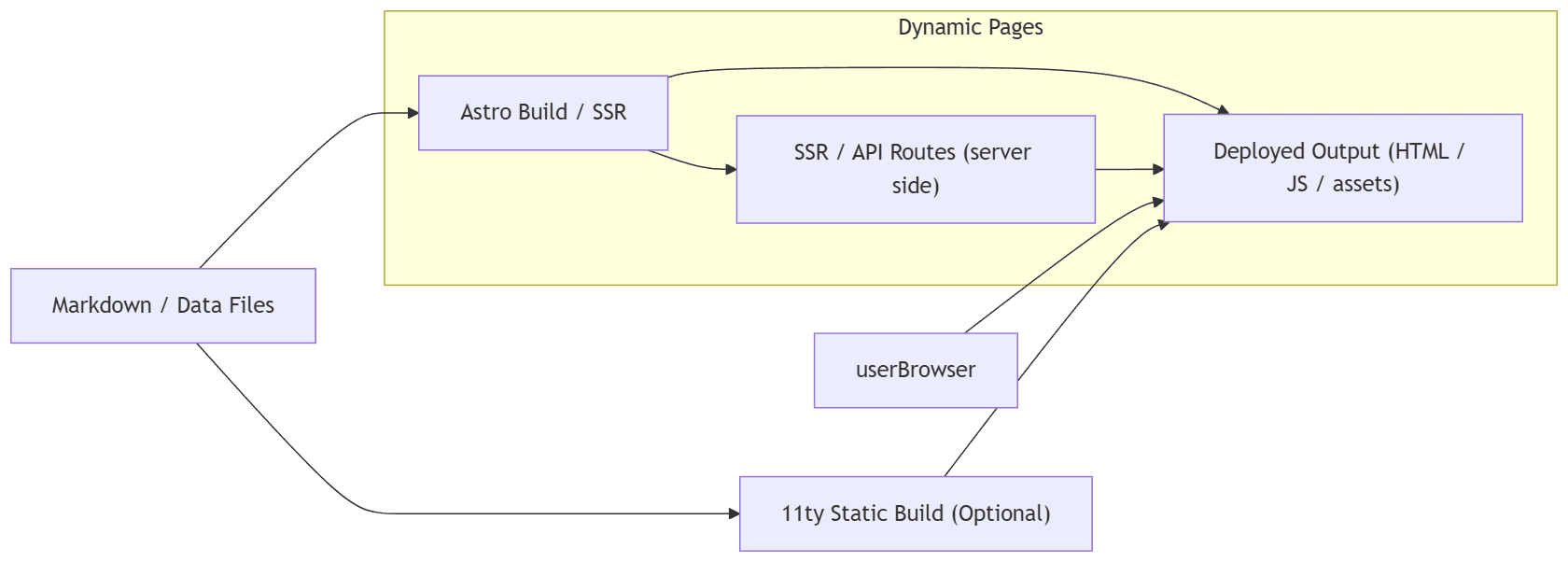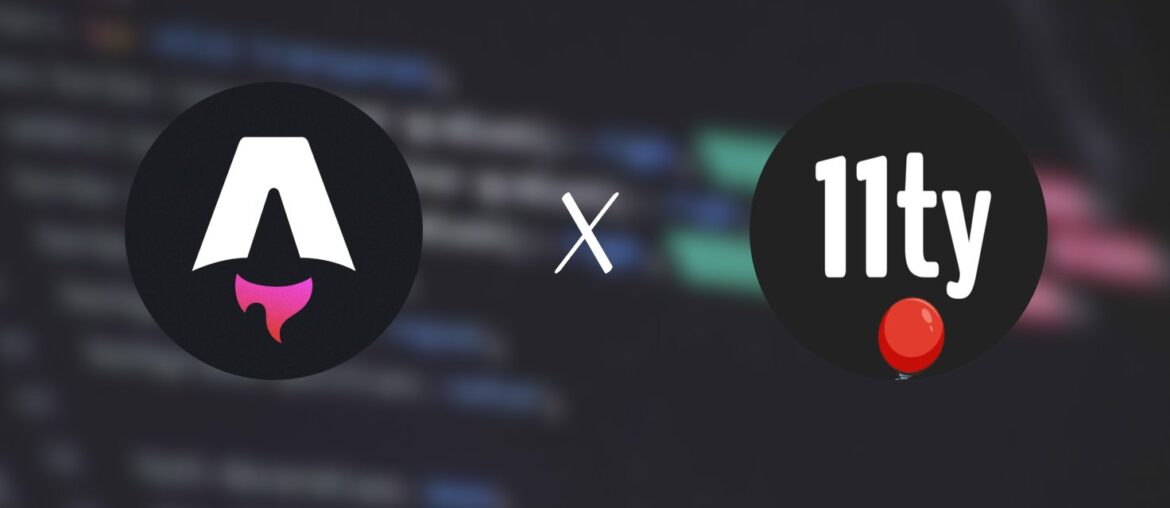To understand where Astro and 11ty stand today, it helps to look back a little at how we got here with static site generators and the “Jamstack” movement.
Back in the early web era, many sites were purely static: files in a folder, served as-is. Then dynamic sites (PHP, Ruby, CMSs) took over for interactivity. But static sites never disappeared entirely. Tools like Jekyll (Ruby) made it easier to maintain many pages without hand-editing every HTML file.
Over time, developers sought a balance: sites that are fast, secure, and simple, but still capable of richer UI and interactivity. That’s where the modern static site generator (SSG) and Jamstack architectures took off. An SSG lets you write content (Markdown, templates, data files) and compile ahead-of-time into HTML, CSS, and JS. Then you host those artifacts on CDN or static hosting. This approach reduces server complexity and improves performance and scalability.
Into this landscape steps 11ty (Eleventy) and Astro, each with its own philosophy and trade-offs.
Eleventy (11ty): the lean, flexible veteran

Eleventy was created in 2017 by Zach Leatherman as a JavaScript alternative to Jekyll. From the beginning, 11ty embraced simplicity, flexibility, and minimal “magic.” It supports many templating languages (Liquid, Nunjucks, Handlebars, etc.) and gives you low-level control over how your content is transformed. It’s “static-first” — it doesn’t assume client-side JavaScript, and you only add that when you explicitly want interactivity.
Over time, 11ty matured. In October 2024 it released version 3.0 with full ESM support (so configs, data files, templates can all use ES modules), support for Deno, async config, and performance improvements. Its community is steady and values backward compatibility: it’s well known that older 11ty projects often still run with minimal changes on newer versions.
Astro: the opinionated performance-first newcomer

Astro is newer (initial releases around 2021–2022) and has evolved fast. From the start, its core differentiator was “island architecture”: by default, pages are rendered to static HTML and only interactive components are hydrated client-side (if needed). This helps minimize the amount of JavaScript sent to the browser. Over time, Astro has morphed from being a pure static site generator into more of a hybrid web framework: you can use static site generation (SSG) or server-side rendering (SSR) for pages, depending on your needs. It supports multiple UI frameworks (React, Svelte, Vue, Solid, etc.) in the same project.
In its 5.0 release, Astro introduced features like Server Islands (deferred rendering), merging static and hybrid output modes, improved environment variable handling, etc. The idea is: you get high performance out of the box, but you can scale into more dynamic use cases without switching tools.
Because of its features, Astro has become very popular for building content-rich sites (blogs, docs, marketing sites) that need occasional interactivity.
So by 2025, we have two mature (ish) players, each with their strengths and philosophies. Let’s compare them side by side.
Core Comparison: Astro vs 11ty in 2025
Below I walk through key dimensions you should care about, with real-world trade-offs. I’ll try to keep this grounded in how things really feel in day-to-day development.
Approach & philosophy
At its core, 11ty is minimalist and unopinionated. It gives you the plumbing; you wire up exactly how you want content flows, templating, asset bundling, etc. It won’t hide anything from you. This is a strength if you prefer full control.
Astro is more opinionated. It gives you a structure (e.g. src/, src/pages, public/), component and layout conventions, and built-in optimizations. It trades some flexibility to reduce boilerplate. The advantage is you get a lot of performance, tooling, and structure without reinventing everything.
Which approach is better depends on your style. If you want “just write content and templates and glue pieces manually,” 11ty may feel more comfortable. If you prefer a more guided experience and want the framework to handle common concerns (bundling, hydration, image optimization), Astro delivers more out of the box.
Templating & component model
In 11ty you can choose among many templating languages: Markdown, Liquid, Nunjucks, Handlebars, EJS, etc. You mix and match in one project if needed. Because the templating is decoupled, you often see 11ty used for content-heavy sites where fine control over markup is important.
By contrast, Astro encourages use of “.astro” files, which combine HTML-like templates with optional script sections, and supports embedding components from React, Vue, Svelte, etc. The template + script blocks let you query data or fetch content, then output HTML with logic, looping, conditionals, etc. The component model makes UI composition more natural than in pure templating languages.
Here’s a simple Astro page example:
---
import Layout from "../layouts/Layout.astro";
import { getPosts } from "../data/posts";
const posts = await getPosts();
---
<Layout title="Blog">
<h1>Blog Posts</h1>
<ul>
{posts.map(p => (
<li><a href={`/posts/${p.slug}`}>{p.title}</a></li>
))}
</ul>
</Layout>In 11ty, a comparable page might be written in Nunjucks or Liquid, pulling in data files or JavaScript helpers. The logic is more separated, often handled via global data or filters.
Because Astro leans into components, it feels more familiar if you’re used to component-based frameworks (React, Vue, etc.). Astro has a nicer developer experience in terms of tooling, autocomplete, and formatting.
Performance & JavaScript strategy
One of the biggest differentiators is how much JavaScript you ship to the browser.
- 11ty: By default, it outputs static HTML and does not assume any JavaScript. If you need dynamic behavior, you bring in client-side scripts yourself (e.g. Alpine.js, custom JS). Because the default is “no extra JS,” it’s often very lean in runtime.
- Astro: It strives for “zero JavaScript by default” (i.e. if no client-side interactivity is required, nothing is shipped). For interactive parts, it uses partial hydration or islands architecture: only interactive components are hydrated, not the entire page. This reduces the JavaScript payload and improves performance. In Astro’s 5.0, features like Server Islands allow deferring rendering of interactive parts.

In practice: simple content pages in both perform well. But for pages with a few interactive widgets (e.g. comments, search, embedded maps), Astro’s model tends to scale better, only hydrating what’s needed.
Build speed, complexity & scaling
Build times and tooling complexity matter especially as your site grows.
- 11ty typically has very fast builds. Because it’s a simple pipeline (read content, run templates, output HTML), overhead is low. Many 11ty users praise its speed and predictability. Because there’s less “framework machinery,” builds remain fast even for moderately sized sites.
- Astro’s build is more complex: bundling, component compilation, hydration logic, etc., are included. That adds overhead. But Astro tooling is improving and using good caching, incremental builds, and smarter build optimizations. In many use cases, the difference becomes acceptable. Also, Astro’s flexibility (choosing static vs SSR for certain pages) gives you levers to optimize.
If your site is small to medium (few hundreds of pages), both are more than capable. At scale (thousands of pages, many assets or interactive parts), the extra complexity of Astro may reveal trade-offs (e.g. needing to fine-tune build caching, caching component builds, etc.). 11ty’s simpler pipeline often remains robust.
Dynamic behavior, SSR, and hybrid modes
This is where Astro has an advantage: ability to incorporate more dynamic and hybrid behavior without switching stack.
Astro supports:
- Static site generation (SSG): build pages ahead-of-time
- Server-side rendering (SSR): for pages that need server logic or dynamic behavior
- Hybrid mode / deferred rendering: mixing static and dynamic rendering in one site
So if you start with mostly static content but later want a page with user-specific data (e.g. a dashboard, logged-in features), Astro can accommodate that without moving to a full-blown SPA or separate backend.
11ty doesn’t natively offer SSR or hybrid rendering. You can integrate some dynamic behavior (e.g. via serverless functions, or client-side JS), but it’s not first-class. The focus remains static. If your use case remains mostly static or content-driven, that’s OK. But if you foresee significant dynamic growth, Astro gives you more headroom.
Ecosystem, integrations & community
No tool matters only on features — community, plugins, adoption, documentation, maintainers all count.
11ty
- Has a mature plugin ecosystem. Because it’s minimalist, many “plugins” are small utilities (filters, transforms, shortcodes).
- Its community is stable and values backward compatibility. Many open-source sites and blogs use 11ty.
- Its core team is small but respected. Version 3.0 was released after careful development.
- Because it doesn’t prescribe many abstractions, it’s easier to integrate with custom workflows, custom build pipelines, or non-standard setups.
Astro
- Rapidly growing ecosystem. You’ll find many themes, integration with headless CMS, image optimization, routing, UI component libraries, etc.
- Because Astro combines UI component frameworks, its ecosystem draws from React/Vue/Svelte communities too.
- Its documentation is considered excellent and a common praise point.
- Because Astro continues evolving (e.g. 5.0 features), there’s more momentum but also more “changing surface area” (i.e. features being added or refined). Some users note occasional friction as the framework evolves.
Developer experience & tooling
What it feels like to actually build and iterate in these tools has been one of the biggest factors for me. With Astro, I really enjoy working on component logic because the developer experience is smooth — autocomplete, type safety, and the way I can co-locate logic and markup in .astro files feels elegant and natural. That said, I’ve run into some friction when things get more complex. The “JavaScript in templates” style can start to feel clunky when I’m dealing with heavier template logic or more advanced slot rendering.
On the other hand, with 11ty I find myself doing more of the plumbing by hand. Setting up asset bundling, CSS pipelines, image optimization, or adding interactivity usually means pulling in extra tools or plugins. Still, I actually appreciate that trade-off because it keeps the moving parts visible and predictable. I’ve also noticed that my older 11ty projects continue to run without much fuss — the long-term stability has been a real plus.
With Astro, the thing that keeps me coming back is how fast the iteration feels. Hot reloads are quick, and the integration with JavaScript frameworks makes it feel like a modern, forward-looking choice.
Use cases & when each is a better match
Knowing when to choose one over the other is what really matters. Below are some general guidance and typical scenarios.
Choose Eleventy (11ty) when:
- Your site is mostly content: blog, documentation, marketing pages, static pages.
- You want maximal control over output markup, HTML structure, and minimal “framework overhead.”
- You prefer simple, predictable builds and minimal abstraction.
- You want to integrate legacy templates or custom pipelines without fighting a framework.
- You don’t expect heavy dynamic interactivity or SSR-based pages.
Choose Astro when:
- You still have mostly static pages but want to sprinkle in interactive components (e.g. comments, search, maps, widgets).
- You want a smoother path toward hybrid rendering or SSR down the line.
- You prefer component-based development and want to use UI frameworks you already know.
- You’re comfortable with the “framework tradeoffs” and are willing to accept extra build complexity for gains in DX and performance.
- You want many built-in optimizations (image processing, bundling, code splitting) handled for you.
In practice, many devs nowadays pick Astro when starting new content-driven sites with some interactivity potential. But 11ty remains a strong, dependable, performant tool for pure static content use cases, especially when control, simplicity, or long-term stability matter more.
Migration, hybrid strategies & combining the two
If you already have a site built in one or the other, or want to adopt gradually, here are some strategies and considerations.
Migrating 11ty → Astro
Astro provides a migration guide from Eleventy.
Key steps include:
- Moving your content (Markdown, data files) into Astro’s
src/folder (oftensrc/pages,src/content). - Rewriting layout and template logic into
.astrocomponents. - Replacing 11ty data or global filters/shortcodes with equivalent component logic or helper modules in Astro.
- Configuring or replacing custom pipelines (e.g. CSS, JS bundling) with Astro’s built-in tooling or integrations.
- Ensuring existing site logic, redirects, APIs, etc. are ported appropriately.
Because 11ty is unopinionated, many existing builds use custom scripts or pipelines. That means migration may require rethinking those parts. But the overlap is often large: both systems use Markdown, data files, and JavaScript logic behind the scenes.
Hybrid or side-by-side approaches
In some cases, teams run parts of the site in 11ty (for stable, low-change pages) and parts in Astro (for newer sections needing interactivity). This is possible (e.g. subdomains, micro-frontends), though you lose some consistency.
Another idea: begin your site in 11ty, then migrate pages gradually into Astro sections as needed.
If dynamic pages are rare, you might still choose 11ty and use serverless functions or client-side JS for those parts. It’s just more manual work.
Architecture visualization
Here’s a simplified architecture overview of how a hybrid Astro site might look:
flowchart LR
contentRepo["Markdown / Data Files"] --> buildAstro["Astro Build / SSR"]
contentRepo --> buildStatic["11ty Static Build (Optional)"]
buildAstro --> deploy["Deployed Output (HTML / JS / assets)"]
buildStatic --> deploy
userBrowser --> deploy
subgraph DynamicPages [Dynamic Pages]
buildAstro --> server["SSR / API Routes (server side)"]
server --> deploy
end

In this model:
- Some content is handled entirely by Astro (static + SSR).
- Optionally some legacy or ultra stable pages remain in pure static form via 11ty or external builds.
- The deployment stage is unified: all HTML, client JS, assets are deployed to a hosting environment or CDN.
You can also simplify: drop 11ty entirely and let Astro handle everything.
Other things I have observed
Over time I’ve noticed some clear patterns with both tools. 11ty tends to feel more solid and predictable, especially when it comes to long-term maintenance. I’ve taken old 11ty projects — even ones a couple of years out of date — and they usually still run with minimal changes.
Astro, on the other hand, sometimes throws surprises. Managing hydration, script ordering, or how components depend on each other can take a deeper understanding, and big updates occasionally require extra refactoring. The team usually documents those changes well, but it’s something to keep in mind.
When projects get large, I’ve also found that Astro’s .astro files can get harder to read if the template logic is heavy or deeply nested. By comparison, 11ty keeps things a bit cleaner in that scenario.
In 11ty, though, you have to assemble more of your own toolchain — image optimization, responsive images, CSS bundling, multiple output formats — but at least that overhead is predictable. With Astro, build size and caching sometimes need extra configuration on really big sites to keep compile times reasonable.
Summary & decision guide
Here’s a distilled summary and decision prompts:
Strengths of 11ty
- Simpler, minimal abstraction
- Very predictable and stable over time
- Maximum control over output
- Fast builds for static-only workflows
- Mature, low-surface-area complexity
Strengths of Astro
- Built-in component model and hydration
- Support for SSR, hybrid rendering
- Many built-in optimizations and developer conveniences
- Better path for adding interactivity later
- Good tooling, DX, ecosystem momentum
When to choose which
- Pure content / blog / doc site → 11ty is often sufficient and safer.
- Content + occasional interactive features → Astro gives you tools without overcomplicating.
- If you anticipate dynamic pages (user accounts, dashboards, etc.) → Astro handles it more smoothly.
- If you value long-term stability and minimal surprises → 11ty’s leaner approach may age more gracefully.
- If you already know React/Vue/Svelte and want a unified toolchain → Astro feels more natural.










